
Home - Search - Browse - Alphabetic Index: 0- 1- 2- 3- 4- 5- 6- 7- 8- 9
A- B- C- D- E- F- G- H- I- J- K- L- M- N- O- P- Q- R- S- T- U- V- W- X- Y- Z
Apollo 7
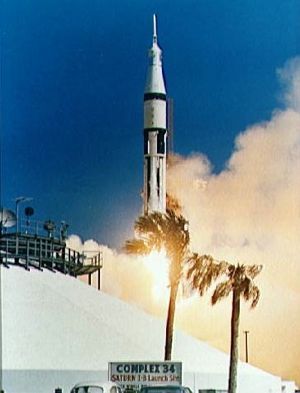 Saturn 1B LC34 Credit: NASA |
Launched: 1968-10-11. Returned: 1968-10-22. Number crew: 3 . Duration: 10.84 days. Location: Museum of Science and Technology, Ottawa, Canada.
Apollo 7 (AS-205), the first manned Apollo flight, lifted off from Launch Complex 34 at Cape Kennedy Oct. 11, carrying Walter M. Schirra, Jr., Donn F. Eisele, and R. Walter Cunningham. The countdown had proceeded smoothly, with only a slight delay because of additional time required to chill the hydrogen system in the S-IVB stage of the Saturn launch vehicle. Liftoff came at 11:03 a.m. EDT. Shortly after insertion into orbit, the S-IVB stage separated from the CSM, and Schirra and his crew performed a simulated docking with the S-IVB stage, maneuvering to within 1.2 meters of the rocket. Although spacecraft separation was normal, the crew reported that one adapter panel had not fully deployed. Two burns using the reaction control system separated the spacecraft and launch stage and set the stage for an orbital rendezvous maneuver, which the crew made on the second day of the flight, using the service propulsion engine.
Crew and spacecraft performed well throughout the mission. During eight burns of the service propulsion system during the flight, the engine functioned normally. October 14, third day of the mission, witnessed the first live television broadcast from a manned American spacecraft. The SPS engine was used to deorbit after 259 hours 39 minutes of flight. CM-SM separation and operation of the earth landing system were normal, and the spacecraft splashed down about 13 kilometers from the recovery ship (27.32 N 64.04 W), the U.S.S. Essex, at 7:11 a.m. EDT October 22. Although the vehicle initially settled in an apex-down ("stable 2") attitude, upright bags functioned normally and returned the CSM to an upright position in the water. Schirra, Eisele, and Cunningham were quickly picked up by a recovery helicopter and were safe aboard the recovery vessel less than an hour after splashdown.
All primary Apollo 7 mission objectives were met, as well as every detailed test objective (and three test objectives not originally planned). Engineering firsts from Apollo 7, aside from live television from space, included drinking water for the crew produced as a by-product of the fuel cells. Piloting and navigation accomplishments included an optical rendezvous, daylight platform realignment, and orbital determination via sextant tracking of another vehicle. All spacecraft systems performed satisfactorily. Minor anomalies were countered by backup systems or changes in procedures. With successful completion of the Apollo 7 mission, which proved out the design of the Block II CSM (CSM 101), NASA and the nation had taken the first step on the pathway to the moon.
Although the systems worked, the crew became grumpy with head colds and talked back to the ground. As a result, NASA management determined that none of them would fly again.
Official NASA Account of the Mission from Chariots for Apollo: A History of Manned Lunar Spacecraft, by Courtney G Brooks, James M. Grimwood, Loyd S. Swenson, published as NASA SP-4205 in the NASA History Series, 1979.
The first manned Apollo flight - Apollo 7 - sped skyward from Launch Complex 34 a few minutes after 11:00 on the morning of 11 October. Once Saturn IB 205 and CSM-101 (the first Block II CSM) cleared the pad in Florida, a three-shift mission control team - led by flight directors Glynn Lunney, Eugene Kranz, and Gerald D. Griffin - in Houston took over. Schirra, Eisele, and Cunningham inside the command module had listened to the sound of propellants rushing into the firing chambers, had noticed the vehicles swaying slightly, and had felt the vibrations at ignition. Ten and a half minutes after launch, with little bumpiness and low g loads during acceleration, Apollo 7 reached the first stage of its journey, an orbital path 227 by 285 kilometers above the earth.
A few hours later, as the spacecraft separated from the S-IVB stage and then turned back in a simulated docking approach, Cunningham described the S-IVB, which would be used for rendezvous target practice the next day. The spacecraft-lunar module adapter panels, he said, had not fully deployed - which naturally reminded Stafford, on the capsule communicator (CapCom) console, of the "angry alligator" target vehicle he had encountered on his Gemini IX mission. This mishap would have been embarrassing on a mission that carried a lunar module, but the panels would be jettisoned explosively on future flights.
After this niggling problem, service module engine performance was a joy. This was one area where the crew could not switch to a redundant or backup system; at crucial times during a lunar voyage, the engine simply had to work or they would not get back home. On Apollo 7, there were eight nearly perfect firings out of eight attempts. On the first, the crew had a real surprise. In contrast to the smooth liftoff of the Saturn, the blast from the service module engine jolted the astronauts, causing Schirra to yell "Yabadabadoo" like Fred Flintstone in the contemporary video cartoon. Later, Eisele said, "We didn't quite know what to expect, but we got more than we expected." He added more graphically that it was a real boot in the rear that just plastered them into their seats. But the engine did what it was supposed to do each time it fired.
With few exceptions, the other systems in the spacecraft operated as they should. Occasionally, one of the three fuel cells supplying electricity to the craft developed some unwanted high temperatures, but load-sharing hookups among the cells prevented any power shortage. The crew complained about noisy fans in the environmental circuits and turned one of them off. That did not help much, so the men switched off the other. The cabin stayed comfortable, although the coolant lines sweated and water collected in little puddles on the deck, which the crew expected after the Kerwin team's test in the altitude chamber. Schirra's crew vacuumed the excess water out into space with the urine dump hose.
Visibility from the spacecraft windows ranged from poor to good, during the mission. Shortly after the launch escape tower jettisoned, two of the windows had soot deposits and two others had water condensation. Two days later, however, Cunningham reported that most of the windows were in fairly good shape, although moisture was collecting between the inner panes of one window. On the seventh day, Schirra described essentially the same conditions.
Even with these impediments, the windows were adequate. Those used for observations during rendezvous and stationkeeping with the S-IVB remained almost clear. Navigational sighting with a telescope and a sextant on any of the 37 preselected "Apollo" stars was difficult if done too soon after a waste-water dump. Sometimes they had to wait several minutes for the frozen particles to disperse. Eisele reported that unless he could see at least 40 or 50 stars at a time he found it hard to decide what part of the sky he was looking toward. On the whole, however, the windows were satisfactory for general and landmark observations and for out-the-window photography.
Most components supported the operations and well-being of the spacecraft and crew as planned, in spite of minor irritations like smudging windows and puddling water. For example, the waste management system for collecting solid body wastes was adequate, though annoying. The defecation bags, containing a germicide to prevent bacteria and gas formation, were easily sealed and stored in empty food containers in the equipment bay. But the bags were certainly not convenient and there were usually unpleasant odors. Each time they were used, it took the crew member from 45 to 60 minutes, causing him to postpone it as long as possible, waiting for a time when there was no work to do. The crew had a total of only 12 defecations over a period of nearly 11 days. Urination was much easier, as the crew did not have to remove clothing. There was a collection service for both the pressure suits and the inflight coveralls. Both devices could be attached to the urine dump hose and emptied into space. They had half expected the hose valve to freeze up in vacuum, but it never did.
The astronauts finally had a spacecraft large enough to move about in. During Gemini, crewmen had gone outside the craft in an exercise called extravehicular activity, or EVA. In Apollo, quite naturally, the abbreviation became IVA, for intravehicular activity. The crew adapted easily to this new free-floating realm. Schirra said, "All the problems we worried about the spacecraft picking up motions from the crew, no such thing. . . . You get to be quite a gymnast." And Cunningham later added, "The work is almost zero, and you can move any place you want to very freely, and you certainly don't need strong handholds to take care of it." The crew found exercise was important. At first, when the men slept in the couches their bodies curled up into the fetal position, which gave them lower back and abdominal pains. So they almost raced each other for a workout on a stretching device called an Exer-Genie, which relaxed their cramped and aching muscles.
The crew slept well enough, but Schirra complained about round-the-clock operations that disrupted the normal, earth-bound routine. Sleep periods might start as early as 4:00 in the afternoon or as late as 4:00 in the morning. Slayton suggested that all three astronauts sleep at the same time, but Schirra said the machine was flying well and he did not want to make any changes. So Eisele kept watch while the others slept, and then he went to bed. Two sleeping bags were underneath the outboard couches (the center couch could be moved out of the way), and the crewmen could zip themselves into them, wearing their flight coveralls. The bags were not popular, because, they said, the restraints were in the wrong places. Cunningham preferred sleeping in the couch, strapping himself down with a shoulder harness and a lap belt. If two crewmen slept in the couches at the same time, however, one of them was always in the way of spacecraft operations. After the third day, the crew had worked out a routine that allowed all of them to get enough sleep.
Although the astronauts had more than 60 food items to choose from, giving them about 2,500 calories a day, they were not happy with their fare. The bite-size food crumbled and stray particles floated around the cabin. They almost came to hate the high-energy sweets and tried to talk each other out of the more satisfactory breakfast items. Following his Gemini flight, Schirra had said that if he flew on Apollo he was going to take some coffee with him. And he did. During flight and later, the crew emphasized that space food was a long way from satisfying their normal table habits.
The astronauts did use the controversial television camera to show their colleagues in mission control and the public everywhere how they got along in their living quarters, operated the spacecraft, ate, and swam about in the weightlessness of space. When flight plan changes crowded their schedule, Schirra canceled the first of several planned television demonstrations. Slayton tried to change his mind, but the spacecraft commander told him sharply that there would be no show that day. The programs finally began, however, and the crew appeared to enjoy them, using cue cards - "Keep Those Cards and Letters Coming In, Folks" and "Hello from the Lovely Apollo Room High Atop Everything" - supplied by Michael Kapp, who also provided cassettes for their musical enjoyment.
Some of the crew's grumpiness during the mission could be attributed to physical discomfort. About 15 hours into the flight, Schirra developed a bad cold, and Cunningham and Eisele soon followed suit. A cold is uncomfortable enough on the ground; in weightless space it presents a different problem. Mucus accumulates, filling the nasal passages, and does not drain from the head. The only relief is to blow hard, which is painful to the ear drums. So the crewmen of Apollo 7 whirled through space suffering from stopped up ears and noses. They took aspirin and decongestant tablets and discussed their symptoms with the doctors.
Several days before the mission ended, they began to worry about wearing their suit helmets during reentry, which would prevent them from blowing their noses. The buildup of pressure might burst their eardrums. Slayton, in mission control, tried to persuade them to wear the helmets, anyway, but Schirra was adamant. They each took a decongestant pill about an hour before reentry and made it through the acceleration zone without any problems with their ears.
That "magnificent flying machine," as Cunningham called it, circled the earth for more than 260 hours. On 22 October, the crew brought the ship down in the Atlantic southeast of Bermuda, less than two kilometers from the planned impact point. On landing, the craft turned nose down, but the crew quickly inflated the air bags and the ship righted itself. The tired, but happy, voyagers were picked up by helicopter and deposited on the deck of the U.S.S. Essex .
More at: Apollo 7.
Family: Manned spaceflight. People: Cunningham, Eisele, Schirra. Country: USA. Spacecraft: Apollo CSM. Projects: Apollo. Launch Sites: Cape Canaveral. Agency: NASA Houston.
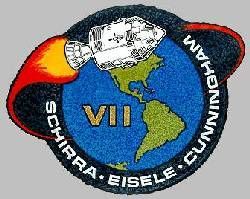 | Apollo 7 Credit: www.spacefacts.de |
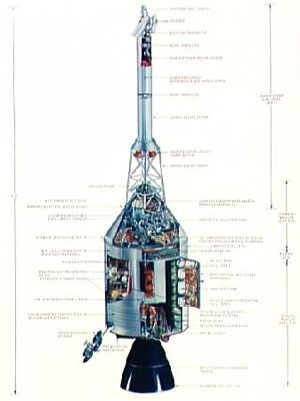 | Apollo 7 Cut-away drawing of Apollo spacecraft Credit: NASA |
 | Apollo 7 KSC Pad 34 showing erection of first stage of Saturn 205 launch vehicle Credit: NASA |
 | Apollo 7 Launch of the Apollo 7 spacecraft Credit: NASA |
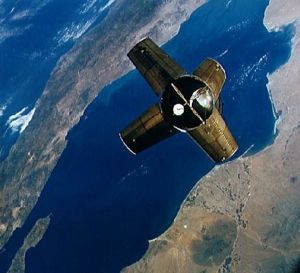 | Apollo 7 Apollo 7/S-IVB Rendezvous in space Credit: NASA |
 | Apollo 7 Apollo 7/S-IVB Rendezvous in space Credit: NASA |
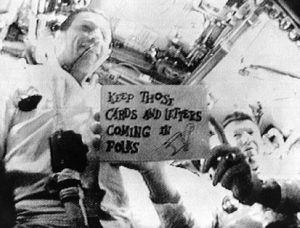 | Apollo 7 Astronauts Schirra and Eisele seen in first live television transmission Credit: NASA |
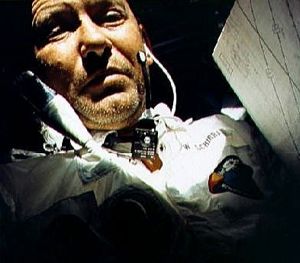 | Apollo 7 Prime crew photographed during Apollo 7 mission Credit: NASA |
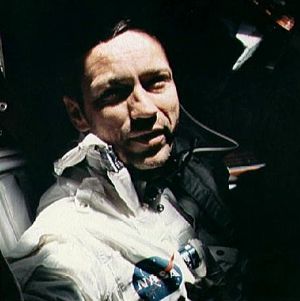 | Apollo 7 Prime crew photographed during Apollo 7 mission Credit: NASA |
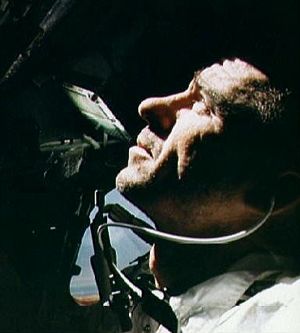 | Apollo 7 Prime crew photographed during Apollo 7 mission Credit: NASA |
 | Apollo 7 Astronaut Walter Cunningham photographed performing flight tasks Credit: NASA |
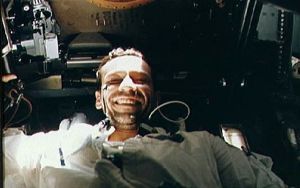 | Apollo 7 Astronaut Don Eisele photographed during Apollo 7 mission Credit: NASA |
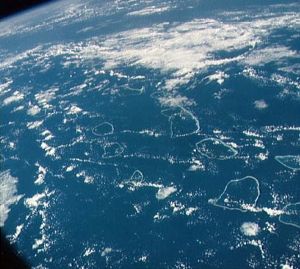 | Apollo 7 Tuamotu Archipelago in South Pacific as seen from the Apollo 7 spacecraft Credit: NASA |
 | Apollo 7 Morning sun on Gulf of Mexico as seen from the Apollo 7 spacecraft Credit: NASA |
 | Apollo 7 Hurricane Gladys, Gulf of Mexico as seen from the Apollo 7 spacecraft Credit: NASA |
1965 March 16 - .
- Adapter panels deployed to 45 degrees would block the command link with the Apollo LEM - .
Nation: USA.
Program: Apollo.
Flight: Apollo 7.
Spacecraft: Apollo LM.
Because the adapter panels, when deployed to 45 degrees, would block the command link with the LEM, a command antenna system on the adapter was mandatory. MSC therefore directed North American to provide such a device on the adapters for spacecraft 014, 101, and 102. This would permit command acquisition of the LEM in the interval between panel deployment and the spacecraft's clearing the adapter.
1965 August 23 - .
- Ground rules for qualifying equipment for Apollo Block II - . Nation: USA. Related Persons: Shea. Program: Apollo. Flight: Apollo 7. Spacecraft: Apollo CSM, CSM Block II. Joseph F. Shea, ASPO Manager, summarized ground rules on the schedules for qualifying and delivering equipment for Block II spacecraft,. Additional Details: here....
1965 October 20-21 - .
- North American agreed to maintain mockups of both of the two blocks of Apollo CMs - . Nation: USA. Program: Apollo. Flight: Apollo 7. Spacecraft: Apollo CSM, CSM Block II. To support studies on equipment stowage, North American agreed to maintain mockups of the crew compartments in the two blocks of CMs. The contractor's effort would be geared for the first manned flight for each series of vehicles (spacecraft 012 and 101)..
1966 July 13 - . Launch Vehicle: Saturn V.
- Apollo mission discontinuity leading to the lunar landing - .
Nation: USA.
Related Persons: Kraft,
Shea.
Program: Apollo.
Flight: Apollo 204,
Apollo 7.
Spacecraft: Gemini.
MSC Director of Flight Crew Operations Donald K. Slayton and Director of Flight Operations Christopher C. Kraft, Jr., told ASPO Manager Joseph F. Shea: "A comprehensive examination of the Apollo missions leading to the lunar landing indicates that there is a considerable discontinuity between missions AS-205 and AS-207/208". Additional Details: here....
1966 October 11 - .
- Tracking ship support for Apollo AS-204 mission - . Nation: USA. Program: Apollo. Flight: Apollo 204, Apollo 7. NASA reiterated its intention of examining the question of tracking ship Vanguard support for the AS-204 mission in the South Pacific as soon as mission plans were resolved. . Additional Details: here....
1966 November 25 - .
- Apollo MSC to rearrange flights after AS-204 - .
Nation: USA.
Program: Apollo.
Flight: Apollo 7.
MSC was requested by NASA Hq. to take the following actions:
- Delete all experiments assigned to AS-205.
- Assign experiment M005 (Bioassays Body Fluid, modified version) to AS-205/208.
- Assign experiment M006 (Bone Demineralization) to AS-205/208.
- Assign experiment M011 (Cytogenic Blood Studies) to AS-205/208.
- Assign experiment M023 (Lower-Body Negative Pressure) to AS-205/208.
- Redesignate experiments assigned to AS-207/208 to AS-205/208.
1966 December 22 - . Launch Vehicle: Saturn V.
- Crew selection for the second and third manned Apollo missions - . Nation: USA. Related Persons: Anders. Program: Apollo. Flight: Apollo 7, Apollo 8. Spacecraft: Apollo LM. NASA announced crew selection for the second and third manned Apollo missions. . Additional Details: here....
1967 February 27 - .
- NASA officials testified on the Apollo 204 fire - . Nation: USA. Program: Apollo. Flight: Apollo 204, Apollo 7. NASA officials testified in an open hearing of the Senate Committee on Aeronautical and Space Sciences on the Apollo 204 fire. . Additional Details: here....
1967 March 15 - . Launch Vehicle: Saturn V.
- Rendezvous with S-IVB stage primary objective of Apollo 7 - . Nation: USA. Related Persons: Kraft. Program: Apollo. Flight: Apollo 7. Spacecraft: Apollo CSM. MSC Director of Flight Crew Operations Donald K. Slayton requested that a rendezvous of the CSM with its launch vehicle S-IVB stage be a primary objective of the Apollo 2 mission.. Additional Details: here....
1967 March 29 - April 4 - .
- Apollo CSM 101 wire bundles inspected - . Nation: USA. Program: Apollo. Flight: Apollo 7. Spacecraft: Apollo CSM, CSM Block II. H. C. Creighton, A. R. Goldenberg, and Guy N. . Additional Details: here....
1967 April 10 - .
- Two task teams on Apollo CSM electrical systems established - . Nation: USA. Program: Apollo. Flight: Apollo 7. Spacecraft: Apollo CSM, CSM Block II. MSC ASPO Manager George M. Low told Sydney C. Jones, Jr., MSC Communications and Power Branch, that he wanted to establish two task teams on CSM electrical systems. . Additional Details: here....
1967 April 17 - . Launch Vehicle: Saturn V.
- Requirements of the Apollo flight program before the first lunar landing mission - . Nation: USA. Related Persons: Kraft. Program: Apollo. Flight: Apollo 7. Spacecraft: Apollo LM. A meeting at MSC considered requirements of the Apollo flight program before the first lunar landing mission. . Additional Details: here....
1967 April 27 - .
- Reservations on wiring in Apollo CSM 101 - . Nation: USA. Program: Apollo. Flight: Apollo 7. Astronaut Donn F. Eisele. a member of the Block II Wiring Investigating Team, wrote the ASPO Manager his reservations as to whether the wiring in spacecraft 101 could be salvaged and made safe for flight. . Additional Details: here....
1967 April 28 - May 16 - . LV Family: Saturn I. Launch Vehicle: Saturn IB.
- Apollo spacecraft delivery dates - . Nation: USA. Program: Apollo. Flight: Apollo 7. Spacecraft: Apollo LM, LM Structural. Spacecraft delivery date and ground rule discussions were summarized by MSC ASPO Manager George M. Low in a letter to North American Aviation's Apollo Program Manager Dale D. Myers. . Additional Details: here....
1967 May 2-4 - .
- NASA Apollo Block II Redefinition Task Team - . Nation: USA. Program: Apollo. Flight: Apollo 7. Spacecraft: Apollo CSM, CSM Block II. NASA Block II Redefinition Task Team group leaders and CSM Program Manager Kenneth S. Kleinknecht arrived at North American Aviation Space Division at Downey May 2, followed by Task Team Manager Frank Borman the next day. . Additional Details: here....
1967 May 12 - .
- Apollo spacecraft 101 wiring harness to be replaced - . Nation: USA. Program: Apollo. Flight: Apollo 7. Spacecraft: Apollo CSM, CSM Block II. Anthony W. Wardell of the MSC Flight Safety Analysis Office wrote Apollo Manager Low that "the May 10 inspection further substantiates my previous recommendation to replace, rather than rework, the (spacecraft 101 wiring) harness. . Additional Details: here....
1967 May 18 - .
- Crew members for Apollo 7 named - .
Nation: USA.
Program: Apollo.
Flight: Apollo 7.
Spacecraft: Apollo LM,
CSM Block II.
Prime and backup crews for Apollo 7 (spacecraft 101) were named, with the assignments effective immediately. The prime crew for the engineering-test-flight mission was to consist of Walter M. Schirra, Jr., commander; Donn F. Eisele, CM pilot; and R. Walter Cunningham, LM pilot. The backup crew was Thomas P. Stafford, commander; John W. Young, CM pilot; and Eugene A. Cernan, LM pilot. Names had been reported to the Senate Committee on Aeronautical and Space Sciences on 9 May.
1967 May 26 - .
- Review of the Apollo CSM - . Nation: USA. Program: Apollo. Flight: Apollo 7. Spacecraft: Apollo CSM, CSM Block II. NASA Headquarters and MSC officials attended a review of the CSM at North American Aviation in Downey. . Additional Details: here....
1967 June 8 - .
- Larger Apollo drogue parachutes - . Nation: USA. Program: Apollo. Flight: Apollo 7. Spacecraft: Apollo CSM, CSM Block II. At a NASA and North American Aviation management meeting, North American was directed to proceed with development of larger drogue parachutes and staged main chute disreefing, using 5- and 8-second reefing-line cutters. . Additional Details: here....
1967 June 9 - .
- Sequence of Apollo missions following the first manned flight - .
Nation: USA.
Related Persons: Phillips, Samuel.
Program: Apollo.
Flight: Apollo 7.
Spacecraft: Apollo CSM,
CSM Recovery.
Robert O. Aller, NASA OMSF, told Apollo Program Director Samuel C. Phillips that considerable analysis, planning, and discussion had taken place at MSC on the most effective sequence of Apollo missions following the first manned flight (Apollo 7). The current official assignments included three CSM/LM missions for CSM/LM operations, lunar simulation, and lunar capability. MSC's Flight Operations Directorate (FOD) had offered an alternate approach of that sequence by proposing that the third mission be a lunar-orbit mission rather than a high earth-orbit mission. Aller preferred the FOD proposal, since it would offer considerable operational advantages by conducting a lunar-orbital flight before the lunar landing. He recommended Phillips consider that sequence of missions and that consideration be given to including it as a prime or alternate mission in the Mission Assignments Document. "Identifying it in that document," Aller said, "would initiate the necessary detailed planning."
1967 June 17 - .
- Plans made to armor-plate 102 out of 167 solder joints inside the Apollo CM of spacecraft 101 - . Nation: USA. Related Persons: Faget. Program: Apollo. Flight: Apollo 7. Spacecraft: Apollo CSM, CSM Block II. Plans were to armor-plate 102 out of 167 solder joints inside the CM of spacecraft 101, ASPO Manager George M. Low informed Maxime A. Faget, MSC's Director of Engineering and Development. . Additional Details: here....
1967 June 19 - .
- Apollo spacecraft/S-IVB rendezvous for AS-205 mission discussed - . Nation: USA. Program: Apollo. Flight: Apollo 7. H. G. Paul, Chief of Marshal Space Flight Center's Propulsion Division, said it had come to the attention of his office that spacecraft/S-IVB rendezvous to within approximately 100 meters was being considered for the AS-205 mission. . Additional Details: here....
1967 June 28 - .
- Apollo AS-205 experiments - .
Nation: USA.
Program: Apollo.
Flight: Apollo 7.
Spacecraft: Apollo CSM,
CSM Block II.
The Apollo Program Director requested MSC to assign the following experiments to AS-205, spacecraft 101: M006 - Bone Demineralization, M011 - Cytogenic Blood Studies, M023 - Lower Body Negative Pressure, S005 - Synoptic Terrain Photography, and S006 - Synoptic Weather Photography. Additional Details: here....
1967 August 19 - .
- Apollo spacecraft deliveries had slipped - . Nation: USA. Program: Apollo. Flight: Apollo 7. Spacecraft: Apollo CSM, CSM Block II. ASPO Manager George M. Low, in a letter to Dale D. Myers of North American Aviation, expressed disappointment that both spacecraft 2TV-1 and 101 had slipped approximately six weeks. . Additional Details: here....
1967 September 29 - .
- Apollo CSM 101 schedule agreed - .
Nation: USA.
Program: Apollo.
Flight: Apollo 7.
Spacecraft: Apollo CSM,
CSM Block II.
Key dates in the spacecraft 101 schedule were agreed to during a meeting of Samuel C. Phillips, Robert R. Gilruth, George M. Low, and Kenneth S. Kleinknecht with North American management: inspection of wiring, October 7, 1967; completion of manufacturing, December 15, 1967; delivery, March 15, 1968. In addition, several decisions were reached concerning certain systems of spacecraft 101. Among these, it was agreed that the entry monitor system would not be checked out on spacecraft 101.
1967 October 12 - .
- Apollo CSM 101 entry monitor system - . Nation: USA. Program: Apollo. Flight: Apollo 7. Spacecraft: Apollo CSM, CSM Block II. ASPO Manager George Low submitted a memorandum for the record on the September 29 decision not to check out the spacecraft 101 entry monitor system (EMS). . Additional Details: here....
1967 October 20 - .
- Apollo RCS for CSM 101 criticized - . Nation: USA. Program: Apollo. Flight: Apollo 7. Spacecraft: Apollo CSM. The SM reaction control system (RCS) for spacecraft 101 was criticized by C&SM RCS Subsystem Manager Ralph J. Taeuber. . Additional Details: here....
1967 November 13 - .
- Northrop Ventura performance on Apollo parachute system discussed - .
Nation: USA.
Program: Apollo.
Flight: Apollo 7.
Spacecraft: Apollo CSM,
CSM Block II.
ASPO Manager George Low, in a memorandum to CSM Manager Kenneth Kleinknecht, remarked that he had "just read Dale Myers' letter to you . . . on the subject of Northrop Ventura performance. In addition I have . . . read a letter from Dick Horner to me in response to my letter . . . of September 29, 1967. Additional Details: here....
1967 November 16 - .
- Mission rules issued for beach impact for the Apollo 7 - . Nation: USA. Program: Apollo. Flight: Apollo 7. MSC Flight Operations Directorate issued mission rules concerning beach impact for the Apollo 7 mission. . Additional Details: here....
1967 December 5 - .
- Apollo SM-102 static-fire test objectives - .
Nation: USA.
Program: Apollo.
Flight: Apollo 7.
Spacecraft: Apollo CSM,
CSM Block II.
Walter J. Kapryan of the MSC Resident ASPO at KSC told the KSC Apollo Program Manager that one of the primary test objectives of the SM-102 static-fire test was to determine system deterioration caused by the static-fire sequence and exposure to residual hypergolics trapped in the system during subsequent prelaunch operations. Additional Details: here....
1967 December 12 - .
- Customer acceptance readiness review of Apollo CM 101 - . Nation: USA. Program: Apollo. Flight: Apollo 7. Spacecraft: Apollo CSM, CSM Block II. The phase I customer acceptance readiness review (CARR) of CM 101 was held at North American Rockwell in Downey, Calif. . Additional Details: here....
1968 January 9 - . Launch Vehicle: Saturn V.
- Key Apollo program decisions required to certify the Apollo system design summarized - .
Nation: USA.
Program: Apollo.
Flight: Apollo 7,
Apollo 8.
Spacecraft: Apollo LM.
George E. Mueller, NASA OMSF, in a letter to MSC Director Robert R. Gilruth, summarized a number of key Apollo program decisions required in order to emphasize the urgency of priority action in preparations necessary to certify the Apollo system design for manned flight. Additional Details: here....
1968 January 13 - .
- Plans to static-fire the Apollo SPS - . Nation: USA. Program: Apollo. Flight: Apollo 7. Spacecraft: Apollo CSM, CSM Block II. ASPO Manager George M. Low outlined for the NASA Apollo Program Director MSC plans to static-fire the service propulsion system (SPS) as a complete unit. . Additional Details: here....
1968 February 29 - .
- Results of an Apollo wire improvement study submitted - .
Nation: USA.
Program: Apollo.
Flight: Apollo 7.
Spacecraft: Apollo CSM,
CSM Block II.
In response to action required by the CSM 2TV-2 and CSM 101 Wire Board in October 1967, Dale D. Myers, CSM Program Manager at North American Rockwell, submitted to MSC results of a wire improvement study for the umbilical feedthrough area for the lower equipment bay. Additional Details: here....
1968 March 1 - .
- Decision not to static-fire Apollo service modules - . Nation: USA. Program: Apollo. Flight: Apollo 7. Spacecraft: Apollo CSM, CSM Block II. MSC had decided not to static-fire the service modules of Block II spacecraft before flight (specifically, spacecraft 101), ASPO advised NASA Hq. . Additional Details: here....
1968 April 10 - .
- TV camera to be carried in Apollo 7 - . Nation: USA. Program: Apollo. Flight: Apollo 7. Spacecraft: Apollo CSM, CSM Block II. A TV camera would be carried in CM 101 on the first manned Apollo flight, Apollo Program Director Samuel C. Phillips, wrote the ASPO Manager (confirming their discussions). . Additional Details: here....
1968 April 18 - .
- Major requirements for further Apollo SPS testing - . Nation: USA. Program: Apollo. Flight: Apollo 7. Spacecraft: Apollo LM, CSM Block II, CSM SPS. Two major requirements existed for further service propulsion system (SPS) testing at the Arnold Engineering Development Center (AEDC), ASPO Manager George M. Low advised Apollo Program Director Samuel C. Phillips. . Additional Details: here....
1968 June 10 - .
- Flight combustion stability monitor on Apollo 7 - .
Nation: USA.
Related Persons: Faget.
Program: Apollo.
Flight: Apollo 7.
Spacecraft: Apollo CSM,
CSM Block II.
ASPO Manager George M. Low met with Christopher C. Kraft, Jr., and Donald K. Slayton, Directors of MSC Flight and Flight Crew Operations, and several members of their staffs (including astronaut Walter M. Schirra, Jr.) to discuss using the flight combustion stability monitor (FCSM) on the Apollo 7 flight. Additional Details: here....
1968 July 10-11 - .
- Apollo Review Board certifies Apollo CSM 101 and the Block II CSM - . Nation: USA. Program: Apollo. Flight: Apollo 7. Spacecraft: A7L, Apollo CSM, CSM Block II. The Apollo Design Certification Review (DCR) Board met in Houston to examine CSM 101 and the Block II CSM for proof of design and development maturity and to certify the designs for flightworthiness and manned flight safety.. Additional Details: here....
1968 August 7 - . Launch Vehicle: Saturn V.
- George Low promotes idea of flying Apollo 8 as a lunar orbit mission without the Lunar Module - .
Nation: USA.
Related Persons: von Braun.
Program: Apollo.
Flight: Apollo 7,
Apollo 8,
Apollo 9.
Spacecraft: Apollo CSM,
Apollo LM,
CSM Block II,
LM Guidance,
LM RCS.
On August 7, Low asked MSC's Director of Flight Operations Christopher C. Kraft, Jr., to look into the feasibility of a lunar orbit mission for Apollo 8 without carrying the LM. A mission with the LM looked as if it might slip until February or March 1969. The following day Low traveled to KSC for an AS-503 review, and from the work schedule it looked like a January 1969 launch. Additional Details: here....
1968 August 9 - . Launch Vehicle: Saturn V.
- Senior Apollo porject management backs Apollo 8 lunar mission concept - . Nation: USA. Related Persons: Low, George, von Braun. Program: Apollo. Flight: Apollo 7, Apollo 8, Apollo 9. Spacecraft: Apollo CSM, Apollo LTA. August 9 was probably one of the busiest days in George Low's life; the activities of that and the following days enabled the United States to meet the "in this decade" goal.. Additional Details: here....
1968 August 10 - . Launch Vehicle: Saturn V.
- North American not enthusiastic about plan to send Apollo 8 to moon. - . Nation: USA. Related Persons: Low, George. Program: Apollo. Flight: Apollo 7, Apollo 8. Spacecraft: Apollo CSM, Apollo LTA. More detailed reviews within NASA showed there were still no obvious insurmountable problems that might block the plan. However North American was not too receptive to the idea.. Additional Details: here....
1968 August 13 - .
- Design Certification Review for Apollo spacecraft 101 completed - . Nation: USA. Program: Apollo. Flight: Apollo 7. George M. Low, MSC, in a letter to Samuel C. Phillips, OMSF, said that the Design Certification Review (DCR) for spacecraft 101 had been completed; that assigned action items had been resolved; and most of the open items had been closed. . Additional Details: here....
1968 August 15 - . Launch Vehicle: Saturn V.
- Webb briefed on Apollo 8 lunar mission concept. - .
Nation: USA.
Related Persons: Low, George,
Paine,
Phillips, Samuel,
Webb.
Program: Apollo.
Flight: Apollo 7,
Apollo 8.
Spacecraft: Apollo CSM.
Phillips and Paine discussed the plan with Webb in Vienna. Webb wanted to think about it, and requested further information by diplomatic carrier. That same day Phillips called Low and informed him that Mueller had agreed to the plan with the provisions that no full announcement would be made until after the Apollo 7 flight; that it could be announced that 503 would be manned and possible missions were being studied; and that an internal document could be prepared for a planned lunar orbit for December.
1968 August 16 - .
- Launch preparations for the Apollo 7 - .
Nation: USA.
Program: Apollo.
Flight: Apollo 7,
Apollo 8.
Spacecraft: Apollo LM,
CSM Block II.
NASA Associate Administrator for Manned Space Flight George E. Mueller reported to his superiors that launch preparations for the Apollo 7 mission were running ahead of schedule. Spacecraft 101 had been erected and mated with the launch vehicle on August 9. Additional Details: here....
1968 August 17 - . Launch Vehicle: Saturn V.
- Webb approves Apollo 8 lunar orbit mission for December - .
Nation: USA.
Related Persons: Low, George,
Webb.
Program: Apollo.
Flight: Apollo 7,
Apollo 8,
Apollo 9.
Spacecraft: Apollo CSM.
Webb approves Apollo 8 lunar orbit mission for December - but no public announcement until after a successful Apollo 7 flight. Phillips and Hage visited MSC, bringing the news that Webb had given clear-cut authority to prepare for a December 6 launch, but that they could not proceed with clearance for lunar orbit until after the Apollo 7 flight, which would be an earth-orbital mission with basic objectives of proving the CSM and Saturn V systems. Phillips said that Webb had been "shocked and fairly negative" when he talked to him about the plan on August 15. Subsequently, Paine and Phillips sent Webb a lengthy discourse on why the mission should be changed, and it was felt he would change his mind with a successful Apollo 7 mission.
1968 September 17 - .
- Requirements for the flight crew debriefing for the Apollo AS-205 mission - .
Nation: USA.
Program: Apollo.
Flight: Apollo 7.
Ernest B. Nathan, MSFC Cochairman of the Saturn-Apollo Flight Evaluation Panel, sent to MSC Marshall's requirements for the flight crew debriefing for the AS-205 mission. Generally, these requirements called for the crew's visual and sensory evaluation of the launch vehicle's performance and behavior.
1968 September 24 - .
- Launch wind constraint for Saturn IB relaxed - .
Nation: USA.
Program: Apollo.
Flight: Apollo 7.
Apollo Program Director Samuel C. Phillips wrote to his two principal counterparts at MSFC and MSC, Lee B. James and George M. Low, to express his concern that the launch-release wind constraint for the Saturn IB, currently 45 kilometers, was perhaps the most restrictive of all such constraints. Additional Details: here....
1968 September 28 - .
- Review of functional interfaces between launch vehicle and spacecraft for Apollo 7 - . Nation: USA. Program: Apollo. Flight: Apollo 7. Spacecraft: Apollo CSM, CSM Electrical. Results of a joint MSFC-MSC review of functional interfaces between the launch vehicle and spacecraft for Apollo 7 were forwarded to NASA Hq. . Additional Details: here....
1968 September 30 - .
- Launch preparation for Apollo 7 and 8 - . Nation: USA. Program: Apollo. Flight: Apollo 7, Apollo 8. NASA Associate Administrator for Manned Space Flight George E. Mueller summarized for his superiors launch preparation for the near-term missions Apollo 7 and Apollo 8.. Additional Details: here....
1968 October 1-2 - . Launch Vehicle: Saturn V.
- The Apollo Crew Safety Review Board held its fourth meeting at MSC - . Nation: USA. Program: Apollo. Flight: Apollo 7. Spacecraft: Apollo CSM. The Apollo Crew Safety Review Board held its fourth meeting at MSC. . Additional Details: here....
1968 October 2 - .
- Operational philosophy for the Apollo 7 mission - . Nation: USA. Related Persons: Mueller. Program: Apollo. Flight: Apollo 7. Spacecraft: Apollo CSM. George E. Mueller, NASA Associate Administrator for Manned Space Flight, wrote MSC Director Robert R. Gilruth to reemphasize the operational philosophy for the Apollo 7 mission. . Additional Details: here....
1968 October 3 - .
- Apollo 7 flight readiness review - .
Nation: USA.
Program: Apollo.
Flight: Apollo 7.
Senior management from NASA Hq. and the three manned Centers conducted the Apollo 7 flight readiness review at KSC. Crew, space vehicle, and all supporting elements were ready for flight. Countdown-to-launch sequence had started on October 6, and flight preparations were on schedule for launch readiness at 11:00 a.m. EDT on October 11.
1968 October 9 - . LV Family: Saturn I. Launch Vehicle: Saturn IB.
- All changes to Apollo 7 as a result of Apollo 1 fire completed - . Nation: USA. Program: Apollo. Flight: Apollo 7. Spacecraft: Apollo CSM, CSM Block II. NASA Apollo Mission Director William C. Schneider reported completion of all action items pertinent to Apollo 7 assigned by Apollo Program Director Samuel C. Phillips as a result of recommendations by the Apollo Crew Safety Review Board on May 27, 1968.. Additional Details: here....
1968 October 11 - . 15:02 GMT - . Launch Site: Cape Canaveral. Launch Complex: Cape Canaveral LC34. LV Family: Saturn I. Launch Vehicle: Saturn IB.
- Apollo 7 - .
Call Sign: Apollo 7. Crew: Cunningham,
Eisele,
Schirra.
Backup Crew: Cernan,
Stafford,
Young.
Payload: Apollo CSM 101 / S-IVB-205. Mass: 14,674 kg (32,350 lb). Nation: USA.
Agency: NASA Houston.
Program: Apollo.
Class: Moon.
Type: Manned lunar spacecraft. Flight: Apollo 7.
Spacecraft: Apollo CSM.
Duration: 10.84 days. Decay Date: 1968-10-22 . USAF Sat Cat: 3486 . COSPAR: 1968-089A. Apogee: 306 km (190 mi). Perigee: 229 km (142 mi). Inclination: 31.60 deg. Period: 89.90 min.
Apollo 7 (AS-205), the first manned Apollo flight, lifted off from Launch Complex 34 at Cape Kennedy Oct. 11, carrying Walter M. Schirra, Jr., Donn F. Eisele, and R. Walter Cunningham. The countdown had proceeded smoothly, with only a slight delay because of additional time required to chill the hydrogen system in the S-IVB stage of the Saturn launch vehicle. Liftoff came at 11:03 a.m. EDT. Shortly after insertion into orbit, the S-IVB stage separated from the CSM, and Schirra and his crew performed a simulated docking with the S-IVB stage, maneuvering to within 1.2 meters of the rocket. Although spacecraft separation was normal, the crew reported that one adapter panel had not fully deployed. Two burns using the reaction control system separated the spacecraft and launch stage and set the stage for an orbital rendezvous maneuver, which the crew made on the second day of the flight, using the service propulsion engine.
Crew and spacecraft performed well throughout the mission. During eight burns of the service propulsion system during the flight, the engine functioned normally. October 14, third day of the mission, witnessed the first live television broadcast from a manned American spacecraft.
1968 October 21 - .
- Apollo 7 CSM to Downey for postflight testing - .
Nation: USA.
Program: Apollo.
Flight: Apollo 7.
Spacecraft: Apollo CSM,
CSM Block II.
While the flight of Apollo 7 was still in progress, ASPO Manager George M. Low ordered that CSM 101 be returned to Downey as quickly as possible at the end of the mission to begin postflight testing as quickly as possible. Therefore, no public affairs showing of the spacecraft could be permitted.
1968 October 22 - .
- Landing of Apollo 7 - .
Return Crew: Cunningham,
Eisele,
Schirra.
Nation: USA.
Related Persons: Cunningham,
Eisele,
Schirra.
Program: Apollo.
Flight: Apollo 7.
The SPS engine was used to deorbit after 259 hours 39 minutes of flight. CM-SM separation and operation of the earth landing system were normal, and the spacecraft splashed down about 13 kilometers from the recovery ship (27.32 N 64.04 W), the U.S.S. Essex at 11:11 GMT. Although the vehicle initially settled in an apex-down ("stable 2") attitude, upright bags functioned normally and returned the CSM to an upright position in the water. Schirra, Eisele, and Cunningham were quickly picked up by a recovery helicopter and were safe aboard the recovery vessel less than an hour after splashdown.
All primary Apollo 7 mission objectives were met, as well as every detailed test objective (and three test objectives not originally planned). Engineering firsts from Apollo 7, aside from live television from space, included drinking water for the crew produced as a by-product of the fuel cells. Piloting and navigation accomplishments included an optical rendezvous, daylight platform realignment, and orbital determination via sextant tracking of another vehicle. All spacecraft systems performed satisfactorily. Minor anomalies were countered by backup systems or changes in procedures. With successful completion of the Apollo 7 mission, which proved out the design of the Block II CSM (CSM 101), NASA and the nation had taken the first step on the pathway to the moon.
Although the systems worked, the crew became grumpy with head colds and talked back to the ground. As a result, NASA management determined that none of them would fly again. Apollo 7 landed at 07:12 GMT.
1968 October 28 - .
- No static-firing of the Apollo 8 reaction control system on the pad - . Nation: USA. Program: Apollo. Flight: Apollo 7, Apollo 8. Spacecraft: Apollo CSM, CSM Block II. MSC Apollo Spacecraft Program Office Manager George M. Low deleted the requirement for a short static-firing of the Apollo 8 service module reaction control system on the pad before launch (the so-called "burp" firing). . Additional Details: here....
1968 November 8 - . Launch Vehicle: Saturn V.
- Proper spacecraft deployment during the Apollo 8 flight - . Nation: USA. Related Persons: Petrone. Program: Apollo. Flight: Apollo 7, Apollo 8. Spacecraft Bus: Apollo Spacecraft Systems Development Diaries. Spacecraft: CSM Electrical. ASPO Manager George M. Low asked Rocco A. Petrone, Launch Operations Director at KSC, to set up a special task team to review all paperwork and to inspect visually all hardware, to ensure proper spacecraft deployment during the Apollo 8 flight. . Additional Details: here....
1968 November 10 - . Launch Vehicle: Saturn V.
- Success of Apollo 7 clears way for Apollo 8 lunar orbit mission in December. - .
Nation: USA.
Related Persons: Low, George.
Program: Apollo.
Flight: Apollo 7,
Apollo 8.
Spacecraft: Apollo CSM,
Apollo LTA.
Apollo 7 - flown October 11-22 - far exceeded Low's expectations in results and left no doubts that they should go for lunar orbit on Apollo 8. At the November 10 Apollo Executive meeting Phillips presented a summary of the activities; James gave the launch vehicle status; Low reported on the spacecraft status and said he was impressed with the way KSC had handled its tight checkout schedule; Slayton reported on the flight plan; and Petrone on checkout readiness. Petrone said KSC could launch as early as December 10 or 12. Phillips said he would recommend to the Management Council the next day for Apollo 8 to go lunar orbit. Additional Details: here....
1998 April 5 - .
- From the Earth to the Moon is released. - .
Nation: USA.
Flight: Apollo 11,
Apollo 12,
Apollo 13,
Apollo 14,
Apollo 15,
Apollo 17,
Apollo 7,
Apollo 8,
Apollo 9.
Based on the success of the film Apollo 13, Tom Hanks was able to raise $ 68 million to film a television mini-series covering the entire Apollo program. The Apollo 13 episode marked the third fictionalised telling of the tale, this time concentrating on the media handling of the flight and the changing nature of television news. Additional Details: here....
Back to top of page
Home - Search - Browse - Alphabetic Index: 0- 1- 2- 3- 4- 5- 6- 7- 8- 9
A- B- C- D- E- F- G- H- I- J- K- L- M- N- O- P- Q- R- S- T- U- V- W- X- Y- Z
© 1997-2019 Mark Wade - Contact
© / Conditions for Use